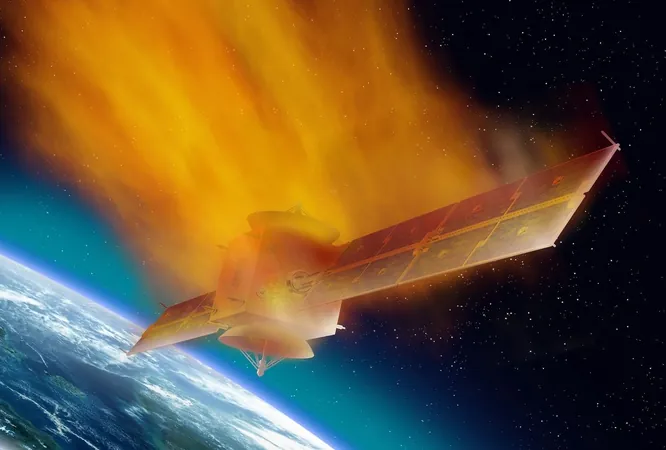
The Alarming Rise of Space Junk: Are We Prepared for a Sky Full of Debris?
2025-04-12
Author: Wei Ling
A Falling Object from Space Shocks Europe
In the early hours of February 19, 2025, residents in western Europe were taken aback when a fiery object blazed across the sky, ultimately crashing into a warehouse in the Polish village of Komorniki. Adam Borucki, the warehouse owner, expressed mixed emotions, saying, "I felt surprised but also scared. Ultimately, I’m glad no one was hurt." Authorities later identified this shocking object as a chunk of debris from a SpaceX Falcon 9 rocket.
Space Junk: A Growing Global Concern
This incident is not an isolated case. Just four months prior, a half-ton piece of debris obliterated trees in a remote Kenyan village. There have also been reports of rocket fragments landing on rooftops in North Carolina and Florida. In 2023, fragments rained down on a home in Uganda, showcasing the escalating problem of space debris impacting life on Earth.
How Likely is it That Space Junk Will Hit You?
While the odds of an individual being struck by space debris are astronomically low—about one in a trillion—experts warn that the overall risk is increasing. According to Ewan Wright, a space sustainability researcher, the likelihood of someone being struck globally is about one in 10,000. In fact, a young boy in China was reportedly injured by falling rocket debris back in 2002, a grim milestone in this growing issue.
More Risks than Just Personal Injury
Falling space debris poses risks beyond just direct hits. There’s a significant danger to commercial and federal airspace. Experts estimate that the busiest airports face a 26% chance yearly of encountering uncontrolled re-entries. Countries like Spain and France have already closed airspace to mitigate this risk during past incidents.
The Burgeoning Space Launches and Their Consequences
With the number of space launches on the rise, 2025 is projected to break records as companies race to establish satellite internet 'megaconstellations.' This surge contributes to an already alarming trend of increasing space debris.
Climate Change Complicates the Situation
Recent research indicates that climate change is having an unexpected effect on low Earth orbit (LEO). As greenhouse gases accumulate, they affect the atmosphere’s density, causing objects to face less drag. This means they linger longer in orbit, increasing the chances of debris falling to Earth, particularly as more satellites flood the skies.
The Threat of Kessler Syndrome
An overcrowded upper atmosphere may trigger Kessler syndrome, where debris collides, creating smaller shards that continue to collide with both junk and operational spacecraft, resulting in a catastrophic chain reaction. Experts warn that this could render entire orbits unusable, creating a hazardous celestial environment.
What Can Be Done About Space Debris?
To combat this growing dilemma, some agencies are adopting 'design for demise' principles, ensuring that spacecraft burn up upon re-entry. However, predicting the effectiveness of this strategy is complicated by our changing atmosphere. For instance, while SpaceX has made strides in designing satellites that disintegrate upon re-entry, failed burns have still led to debris landing on Earth.
Can We Clean Up Space?
Ideas for pulling debris from orbit have been proposed, including gigantic nets and robotic arms. Although no active removal missions are underway, the European Space Agency aims to launch its first cleanup effort, ClearSpace-1, in 2028—a critical step in addressing this mounting issue.
Emergency Management Strategies Are Needed
Some U.S. states that host rocket launch sites are beginning to draft emergency response plans for falling debris. However, these efforts need to be intensified globally to enhance preparedness and safety.
Looking Towards a Safer Future in Space
As the specter of climate change looms and space launches multiply, we must explore more strategic and responsible ways to navigate our increasing presence in space. Aaron Boley emphasizes, "We want to ensure continued safe access to outer space, but the promise of prosperity does not give us permission for recklessness." With careful planning and innovative solutions, we can mitigate the risks of space debris and secure a safer future for all.



 Brasil (PT)
Brasil (PT)
 Canada (EN)
Canada (EN)
 Chile (ES)
Chile (ES)
 Česko (CS)
Česko (CS)
 대한민국 (KO)
대한민국 (KO)
 España (ES)
España (ES)
 France (FR)
France (FR)
 Hong Kong (EN)
Hong Kong (EN)
 Italia (IT)
Italia (IT)
 日本 (JA)
日本 (JA)
 Magyarország (HU)
Magyarország (HU)
 Norge (NO)
Norge (NO)
 Polska (PL)
Polska (PL)
 Schweiz (DE)
Schweiz (DE)
 Singapore (EN)
Singapore (EN)
 Sverige (SV)
Sverige (SV)
 Suomi (FI)
Suomi (FI)
 Türkiye (TR)
Türkiye (TR)
 الإمارات العربية المتحدة (AR)
الإمارات العربية المتحدة (AR)